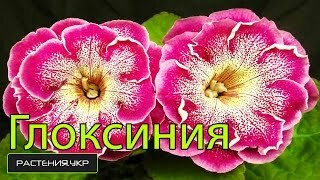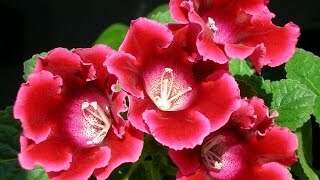The gloxinia flower is a very beautiful short plant that will delight you with a charming, long and varied bloom. This representative of the world of flora enjoys great popularity, both for beginners-florists, and for professionals. Gloxinia - terry or usual in it texture - has thick leaves and bell-shaped flowers.
Gloxinia:
- species Gloxinia is speckled or perennial in height from 50 to 70 cm. Its oval-shaped leaves have pointed tips. They are green on top and reddish underneath. The leaves are glossy and only the occasional villi are visible. Flowers of gloxinia of many years are obtained axillary with long legs. They are assembled on several pieces on one leg. And the calyx has a bell-shaped form. In the upper part it is a purple-bluish hue. Gloksinia mottled spreads mint flavor. Blossoms from September to November.
- Syningia tiny( gloxinia) originally from the rocky moist mountains of Brazil. It reaches 2.5 cm in height. The leaves are rounded, ovoid, up to 1 cm long. In addition, they are hairy-pubescent. The petiolus is very short and only the flowers a little rise above the leaves. They grow on individual pedicels about 1.7 cm tall. Blossoms this species in May-August.
- Gloxinia is beautiful. From tiny is distinguished by larger flowers. In the summer, too, blooms.
Gloxinia: Care and Reproduction
Gloxinia: Reproduction.
Propagated gloxinium from seeds. You can also use a leaf blade, if you want, in your home even richer blossomed gloxinia. Reproduction in this case provides for accurate cutting of the leaf plate( take the blade and wipe it with alcohol), sprinkle the cut with crushed activated carbon, dry for 10-15 minutes and further rooting to ensure the immobility of the cuttings. When replicating, it is important that the humidity is maintained at the desired level, create for the plant greenhouse conditions. Be sure to ventilate the hothouse every three days. Petiolus can be placed in a glass with water. Roots will appear after 2-3 weeks.
Gloxinia: transplant or disembarkation.
First, the tuber gloxinia must be allowed to stand for half an hour in a solution of the fungicide, after which it must still be dried for a whole day. Soil choose a light and weakly acidic. You can add perelit and cocogrun. The pot will need 2-4 cm more than the tuber size. At the bottom of the pot, lay drainage and charcoal. Do not fill the tuber completely with earth. Also gloxinium gently pour around the edges of the pot. Then the plant can be put in a warm place. And only when the tuber gets stronger, it completely covered with earth, so that the stem was more stable.
Gloxinium: watering.
It is best to water the gloxin in a tray. Water for this, use a slightly warm and stagnant. Taking water for cold water from the tap, you will provoke the development of fungal diseases. If the soil dries, the rootlets will die and the next watering will lead to decay of the rootlets. Overdrying is especially terrible for young nodules.
Gloxinium: a period of rest.
In October-November, reduce the watering to once in 3-4 weeks to prevent the drying of the roots. The beginning of the rest period is indicated by leaves that begin to die. Do not dig up the tubers, but just put the pot in a dark and cool place. During this period, the temperature should be 10-12 degrees. Gloxinia for the winter loses stems and leaves and hibernates in the form of tubers.
Gloxinium: air humidity.
Gloxinia will be bad in both dry and too humid conditions. So stick to the "golden mean".Glossinia: fertilizing with fertilizers.
When the rest period( after October-November) is over and the plant wakes up, it is not earlier than a month later that gloxinium can be fed once a week. Suitable kemira luxury.
Gloxinium: lighting.
Gloxinium can be placed under direct sunlight, until buds appear on it. Glossary: temperature.
The main thing - do not allow temperature changes and drafts. And the rest of the gloxinia is not too choosy.
Gloxinia: care and some secrets
Special problems of cultivation are not peculiar to gloxinia. But that she pleased you with her flowering for a long time, after the first flowering, around the beginning of July, the trunks should be cut to the first couple of leaves. With the help of this action, you will stimulate the growth of young shoots. So you can hope for another bloom that you should wait in September.
But if your gloxinia is less than a year, then this can not be done with it, since such plants still have a very small tuber. After all, the more the plant has this part, the more flowers it blossoms at the same time.
Gloxinia: diseases and pests
For gloxinia, the invasion of thrips and various species of mites is dangerous. Preventive actions will prevent this. Only prevention is needed before the flowering period, that is, in the spring. The plant should be treated 3 times with phytophythm. Stick with this interval per week. This drug perfectly fights pests and it is safe for humans.
Related Videos:
 3:11
3:11  3:21
3:21  6:02
6:02 